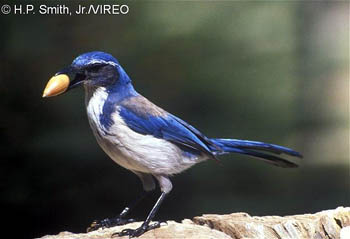Loading ...
Western Scrub-Jay
The Western Scrub-Jay (Aphelocoma californica) is the year-round, blue-and-gray jay of the western United States and central Mexico that lacks a crest. It prefers the drier, low elevation, scrub and open woodland habitats to the montane forests of the crested Steller's Jay. Like other jays, this bird is loud, bold and quick to adapt to living with humans in urban and suburban environments. It is noted for its ability to hide and relocate acorns and other foods. The Western Scrub-Jay's common call is a measured series of harsh, scolding "zreep" notes; unfortunately, the Jay reserves a softer, more musical song for private moments courting its mate.
See all Western Scrub-Jay photosField Marks:
The Western Scrub-Jay's crown, nape, wings and tail are blue (a more intense color on the coast, paler inland), its cheeks are dark gray, its back gray-brown, and its throat and breast are whitish. It has a slight white stripe over the eye and no crest. (L. 11.5 in.)
Distribution:
The Western Scrub-Jay is a permanent resident along the U.S. west coast from the southern part of Washington to the tip of the Baja Peninsula and as far east as Colorado and New Mexico, as well as portions of central Mexico south to Oaxaca.
Similar Species:
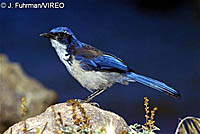 |
Island Scrub-Jay (all photos) The Island Scrub-Jay is endemic to the Channel Islands of California (Santa Cruse) and has black cheeks. |
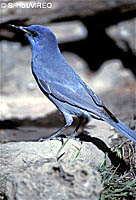 |
Pinyon Jay (all photos)
The Pinyon Jay in the pinyon-juniper woodlands of the interior western U.S.has a more spear-like bill and is blue overall. |
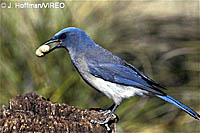 |
Mexican Jay (all photos)
The Mexican Jay has blue, not dark gray, cheeks and its back patch is less distinct; it is restricted to portions of Arizona, Texas and Mexico. |
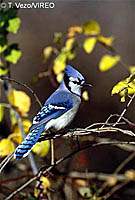 |
Blue Jay (species account) (all photos)
The Blue Jay has a crest and white patches on its wings and tail. |
Habitat & Nesting:
The Western Scrub-Jay nests mostly in open oak and pinyon-juniper woodlands, and sometimes in dense wild-grape covert. In the hotter portion of its range (Mexico), the bird nests at higher elevations.
More Information:
The Western Scrub-Jay is omnivorous. It consumes acorns, seeds, small snakes, lizards, and insects, and it preys upon the eggs and young of other birds. In California, Western Scrub-Jays occasionally pick insects off the head and back of motionless deer. The jays "mob" threatening predators, such as cats, squirrels, owls, and occasionally humans.

